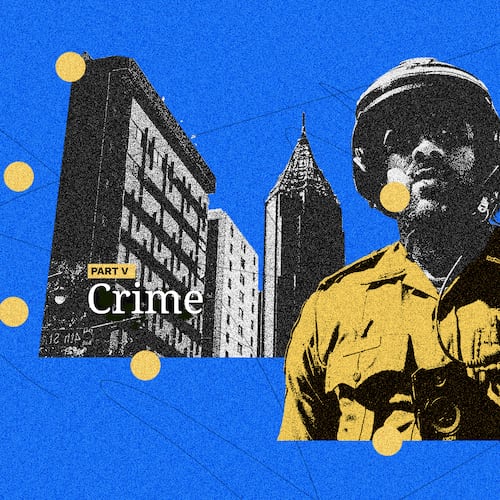The fatal shooting Tuesday night of an unarmed, would-be car thief in Atlanta has reignited a debate over when, or even if, officers should fire at fleeing vehicles.
But the most immediate issue for investigators is getting more clarity about just what happened at a Shell station near the intersection of Whitehall and McDaniel streets.
This much is alleged: According to Atlanta police Officer Oliver Simmonds, a member of Mayor Keisha Lance Bottoms’ security detail, suspect D’Ettrick Griffin, 18, jumped into the driver’s seat of Simmonds’ unmarked SUV while it was parked at a gas pump. Law enforcement calls such incidents “slider” crimes — which, they add, are occurring with greater frequency.
“The vehicle began to drive away and the officer attempted to stop it,” says a statement from the GBI, which is investigating the shooting. “During the incident, the officer discharged his service weapon. The vehicle continued driving south on Whitehall Street, where it struck two other vehicles before stopping.”
It is not yet known how and when Simmonds, who was off-duty, first engaged the suspect and whether those efforts put his safety at risk, necessitating the lethal response.
Griffin didn’t get far before crashing into two parked vehicles, the GBI said. Officers found him dead in the vehicle from multiple gunshots.
Simmonds suffered a minor injury to his foot after Griffin allegedly drove over it. That would indicate close contact, but GBI spokeswoman Nelly Miles said witness statements and video taken of the encounter have yet to paint a clear picture.
RELATED:
Atlanta officer fired as shooting at cars by police gets new scrutiny
Officer in APD annex shooting back at work as investigation continues
Georgia sees spike in deadly police shootings in 2018
Atlanta Police Department policy prohibits officers from firing their weapons to stop a fleeing vehicle but has carved out a broad exception that allows a “reasonable and necessary” use of force.
That exception didn’t exist a generation ago, when Ken Allen, then a young officer, shot at a vehicle driving toward him and two colleagues who had responded to a complaint about drug use at a northeast Atlanta park.
Allen was suspended for three days, a penalty he fought in court. In 1998, four years after the incident, Allen was exonerated when a judge agreed the policy was too restrictive because it violated the officer’s right to self-defense.
“There’s no doubt it saved my life,” Allen told The Atlanta Journal-Constitution in 2016. “It certainly saved me from great injury. I would have taken the full impact of the vehicle.”
But in 2016, Atlanta police fired Officer James Burns after he shot through the passenger-side window of a vehicle as it sped away, killing 22-year-old Deravis Caine Rogers. Burns told investigators that Rogers tried to run him over, but dashcam video and several eyewitnesses told a different story. Burns was indicted for murder and his trial is expected to commence sometime this year.
This latest incident calls to mind a fatal shooting two years ago outside an Atlanta police annex. In that case, Officer Yasin Abdulahad, claiming he smelled marijuana, confronted Deundre Phillips as he was sitting in the passenger’s seat of a friend’s car. Abdulahad, like Simmonds, was dressed in plain clothes at the time.
Abdulahad told the GBI that he was hanging halfway out of the vehicle when he fired his gun, striking Phillips once in the head. But subsequent video showed the officer was fully inside the car when it disappears from view of the annex parking lot.
Phillips’ death remains under investigation by the Fulton County district attorney’s office.
Departments nationwide have increasingly moved to prohibit officers from firing into moving automobiles. In 2016, the San Francisco Police Department banned the practice unless the occupants pose a threat with some other weapon. Philadelphia restricts its officers from firing into vehicles unless they are being fired upon.
The GBI has revised its use-of-force policy to strongly discourage the practice.
Critics blasted the practice as dangerous and ineffective. But Lance LoRusso, a Marietta attorney who has represented many officers, said eliminating that option places cops at greater risk.
“Everyone thinks it’s clear-cut, but the officer doesn’t know what (the suspect’s) intentions are,” said LoRusso, a former officer.
In this latest case, LoRusso disputes the notion that Griffin was unarmed, noting that a car can be a deadly weapon.
“You can’t judge officers from 20/20 hindsight,” LoRusso said. “They’re not always going to make the right call, but what matters is was their decision reasonable.”
Georgia code provides officers with wide discretion, allowing them to use deadly force to stop a fleeing felon. Griffin would have likely faced felony charges had he been apprehended alive.
Simmonds, who joined the APD in 2010, also faces an administrative investigation by the department’s Office of Professional Standards, said Atlanta police spokesman Carlos Campos, “to ensure compliance with our policies and procedures.”
This is the sixth officer-involved shooting in Georgia this year, and the second deadly police shooting this week.
About the Author
The Latest
Featured



